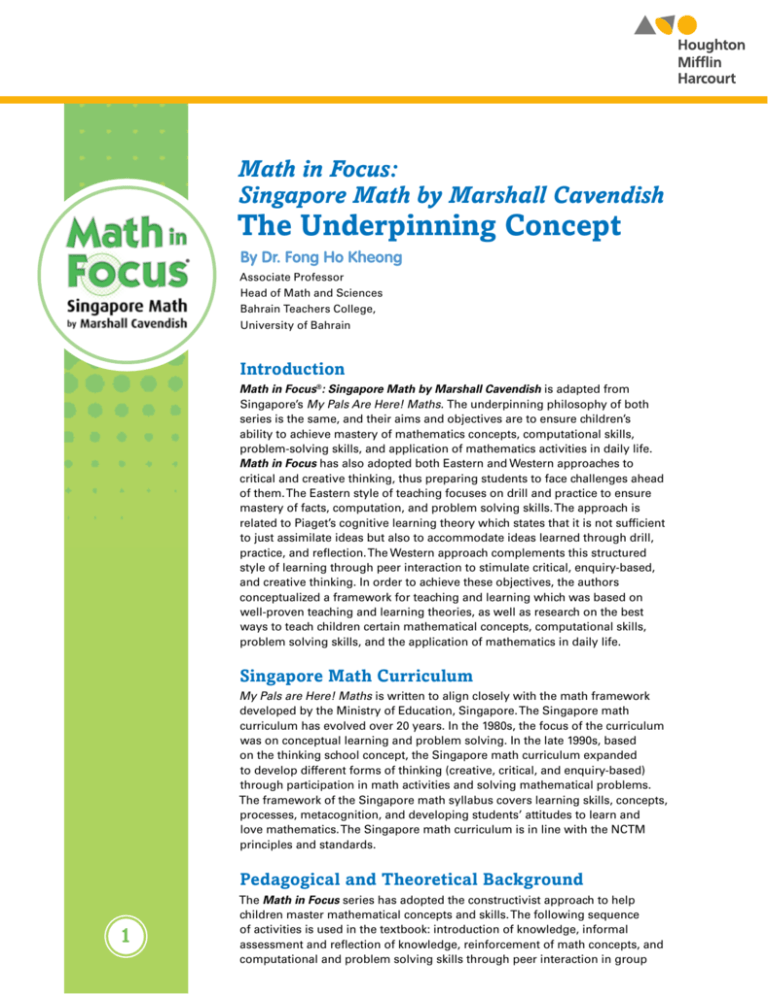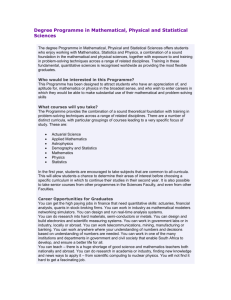
Math in Focus:
Singapore Math by Marshall Cavendish
The Underpinning Concept
By Dr. Fong Ho Kheong
Associate Professor
Head of Math and Sciences
Bahrain Teachers College,
University of Bahrain
Introduction
Math in Focus®: Singapore Math by Marshall Cavendish is adapted from
Singapore’s My Pals Are Here! Maths. The underpinning philosophy of both
series is the same, and their aims and objectives are to ensure children’s
ability to achieve mastery of mathematics concepts, computational skills,
problem-solving skills, and application of mathematics activities in daily life.
Math in Focus has also adopted both Eastern and Western approaches to
critical and creative thinking, thus preparing students to face challenges ahead
of them. The Eastern style of teaching focuses on drill and practice to ensure
mastery of facts, computation, and problem solving skills. The approach is
related to Piaget’s cognitive learning theory which states that it is not sufficient
to just assimilate ideas but also to accommodate ideas learned through drill,
practice, and reflection. The Western approach complements this structured
style of learning through peer interaction to stimulate critical, enquiry-based,
and creative thinking. In order to achieve these objectives, the authors
conceptualized a framework for teaching and learning which was based on
well-proven teaching and learning theories, as well as research on the best
ways to teach children certain mathematical concepts, computational skills,
problem solving skills, and the application of mathematics in daily life.
Singapore Math Curriculum
My Pals are Here! Maths is written to align closely with the math framework
developed by the Ministry of Education, Singapore. The Singapore math
curriculum has evolved over 20 years. In the 1980s, the focus of the curriculum
was on conceptual learning and problem solving. In the late 1990s, based
on the thinking school concept, the Singapore math curriculum expanded
to develop different forms of thinking (creative, critical, and enquiry-based)
through participation in math activities and solving mathematical problems.
The framework of the Singapore math syllabus covers learning skills, concepts,
processes, metacognition, and developing students’ attitudes to learn and
love mathematics. The Singapore math curriculum is in line with the NCTM
principles and standards.
Pedagogical and Theoretical Background
1
The Math in Focus series has adopted the constructivist approach to help
children master mathematical concepts and skills. The following sequence
of activities is used in the textbook: introduction of knowledge, informal
assessment and reflection of knowledge, reinforcement of math concepts, and
computational and problem solving skills through peer interaction in group
activities and practice. Further activities are incorporated to use critical and
creative thinking in the curriculum, such as the investigative activities and Put on
Your Thinking Cap! problems. To help children construct mathematical knowledge
and develop problem-solving skills, presentation of learning concepts needs to
match children’s ability to understand and construct the knowledge. Children
need to see how mathematical concepts are interrelated (emphasized by NCTM
in the current standards and principles) in order to understand and master
such mathematical concepts, solve mathematical problems, and carry out
investigation procedures. Math in Focus emphasizes these interrelationships
so students see the links between concepts and topics, which helps them
understand and solve problems, such as finding the connection between
geometry and numbers.
(i) Adoption of Dr. Jerome Bruner’s and Jean Piaget‘s Theories
The most significant theory, which has been adopted for writing the Math in
Focus series, is Bruner‘s theory on the representations of mathematical concepts
according to different levels of children‘s thinking. The representation based
on the concrete, pictorial, and abstract (CPA) is adopted in the whole series.
Bruner‘s theory parallels Piaget‘s stages of development theory. Children at a
certain age, in general, can only conceptualize mathematical concepts depending
on their level of mental development. In this aspect, Bruner‘s idea was to
emphasize concrete representation, which is in accord with some children‘s
ability to understand mathematical concepts at the early stages. Research
shows that children cannot depend too much on concrete representation, as
they need to move on to the next level so that they can conceptualize abstract
(complicated) situations using pictorial representation, such as in the ‘model’
approach used in Singapore‘s My Pals are Here! Maths and Math in Focus.
Although not all challenging problems can be tackled using the ‘model’ method,
it plays a significant role in helping average and below-average students solve
the problems based on their level of thinking at the concrete and semi-concrete
operational stage.
(ii) Richard Skemp’s Theory of Understanding
The entire Math in Focus series also adopts Skemp‘s theory of instrumental
and relational understanding. The theory here is that when a child understands
in relation to other facts (relational understanding), the child can remember
better than memorizing the facts without really understanding (instrumental
understanding). Relational understanding also helps children to extend their
knowledge in problem solving skills. Understanding this approach is related to
the CPA approach. Using concrete and pictorial representation helps children
to understand the concepts and skills presented.
2
(iii) Theory on Constructivism
The constructivist’s theory is broadly applied in this series. Mathematical ideas
are conceptualized by constructing mathematical concepts and skills through
simulation and accommodation. They are also enforced through various
activities, such as using journals for reflection and reinforcement, in order to
provide continuous practice. During peer interactions, the ideas taught are either
reconstructed or reinforced to enable correction and understanding of ideas
learned. Further constructivist activities are also emphasized to ensure mastery
and student confidence in activities such as journal writing, which places great
emphasis on student’s recall and reflection of the ideas they have learned.
Strategies and Methods
Math in Focus is based upon the use of mental computation, the model approach,
and the heuristics which enhance teaching and learning. Mental computation
is paramount if children are to master mathematical skills and problem solving.
With speed and the ability to operate mentally, children are able to excel in
math. The program introduces not only the mental strategies, but also prepares
students to perform mental sums through the use of number bonds and
manipulatives like unit cubes and the math balance.
The use of the model approach or bar modeling is based on the fact that children
at the elementary stage are unable to solve abstract problems. The introduction
of the model approach helps children to visualize and see connections between
facts and information embedded in the questions. This ability to see the
connections helps pupils to solve difficult and complicated problems. This is
the strength of the model method. In other words, the model method simplifies
the problem solving situation and translates it to a form which average and
below-average students can conceptualize.
The use of heuristics is also another strategy which helps average and
below-average students tackle challenging questions. Based on Richard Gardner‘s
theory, each child has to develop his/her own talent, and only by identifying
the talent can a method be implemented to help them. This philosophy is
adopted in this series. The use of diagrams, manipulatives, games, and active
participation are in accordance with Gardner‘s theory.
Creative, Critical, and Enquiry Thinking
Educationists have advocated creative, critical, and enquiry thinking. Achieving
these thinking skills is the key objective of the Math in Focus series. Creativity
can be trained if the children are put in an environment where their mental
thinking is stimulated. The series contains many activities where they are
asked to create alternative solutions to a problem. Likewise, critical thinking is
stimulated through activities that require children to use their enquiry skills and
abilities on multiple-choice exercises.
Conclusion
The ultimate objective of the Math in Focus series is to develop a program that
enables children to empower their thinking and develop skills that will help lead
them to a better future in society. This can be achieved through getting children
involved in various activities (peer activities and interaction, further practice,
and journal writings), which help to develop creativity, critical thinking, and
enquiring minds.
Math in Focus has adopted some useful research, teaching, and learning
theories to develop the program, and has led the author to write training
materials which help students with mathematical concepts, skills, problem
solving and mathematical investigations. The materials from Math in Focus are
adapted from My Pals are Here! Maths, which is the most popular series used
by Singapore schools. Children using the My Pals are Here! Maths series have
excelled in math and this can be seen in the results of the 2007 TIMSS.
3
About the Author
Dr. Fong Ho Kheong is an Associate Professor
and Head of the Math and Science Department
of the Bahrain Teachers College of the University
of Bahrain in the Kingdom of Bahrain. He is also
a former Associate Professor of the National
Institute of Education, Nanyang Technological
University, Singapore. He was involved in training
Mathematics teachers at the National Institute of
Education, Singapore, for 25 years. He also worked in
the Education Testing Centre, University of New South Wales, Australia, dealing
with assessment in primary mathematics. He is the Founding President of the
Association of the Mathematics Educators, Singapore. Dr. Fong obtained his
Ph.D. from the University of London. He specializes in teaching high-ability
children and children who have problems in Mathematics. His research work
includes diagnosing children with mathematical difficulties, teaching them how
to think when solving mathematical problems, and applying psychological
theories for the teaching and learning of Mathematics. His experience in
curriculum development has led him to innovate the use of the model drawing
approach to tackle challenging problems. He has published more than 100
journal articles and research reports, as well as primary and secondary
mathematics books.
He is the consultant and principal author of Marshall Cavendish’s My Pals are
Here! Maths series, which is currently being used by the majority of primary
schools in Singapore. He is the principal author of Math in Focus: Singapore
Math by Marshall Cavendish, the United States Edition of My Pals are Here!,
also published by Marshall Cavendish and distributed in the U.S. by
Houghton Mifflin Harcourt Specialized Curriculum.
References
Bruner, J. (1966). Toward a Theory of Instruction.
Cambridge, MA: Belknap Press of the Harvard University Press.
Gardner, H. (1993). Frames of Mind: The Theory of Multiple Intelligences.
New York: Basic Books.
Gardner, H. (1999). Intelligences Reframed: Multiple Intelligences for the 21st Century.
New York: Basic Books.
Skemp, R. R. (1987). The Psychology of Learning Mathematics. Hillsdale, NJ: Lawrence Erlbaum
Associates.
Slavin, Robert (2006). Educational Psychology: Theory and Practice. ISBN 0205373402
© Copyright Dr. Fong Ho Kheong 2009
800.289.4490
hmheducation.com/singaporemath
Math in Focus® is a registered trademark of Times Publishing Limited
© Houghton Mifflin Harcourt Publishing Company. All rights reserved. Printed in the U.S.A. 06/13 MS77941p
hmhco.com • 800.289.4490
Math in Focus ® is a registered trademark of Times Publishing Limited
© Houghton Mifflin Harcourt Publishing Company. All rights reserved. Printed in the U.S.A. 5/11 MS24731
Z-1489120







